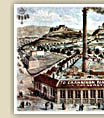|
Industrial development in Greece took a very slow pace. Indeed, there was an accumulation
of capital since the nineteenth century, which was basically invested in trade, brokerage
firms and shipping.
|

Generally speaking, in the period leading up to the Asia Minor Catastrophe, we cannot speak either of
organized industry or of a consistent policy of industrial development
on the part of the state.
In the 1910s, rapid mobilization and its aftermath had favoured local industry.
There were basically three further developments:
- The integration of the New Territories - financially rather underprivileged -
into the national body, with the exception probably of the areas of Thessaloniki and Kavala;
- The problems generally caused by the First World War in world economic
transactions;
- The special conditions caused by the blockade of southern Greece by the Powers of
the Entente in 1916-17, during the period of the National Schism,
and the 'heavy' presence and activity of allied military forces in Greece.
These developments had repercussion in the secondary sector:
in the production of goods for immediate consumption (agricultural and animal husbandry products, clothing items, etc.) - absolutely necessary
for survival in conditions of war and blockade. These products were of low quality,
disproportionately high prices and in peaceful conditions would not be competitive
in the Greek market. The industrialists developed a philosophy of easy and rapid profit
without investing in mechanical equipment and with no business planning
and perspective whatsoever.
More specifically, in 1920 industrial and manufacturing
firms took stock. There were 33,385 of these businesses and the number
of employed 143,977. 91.1 per cent of these entreprises employed between
one and three employees, whereas only 1.3 per cent employed more than twenty five.
It is evident that small manufacturing and family businesses with few employees were more common.
|
 |
